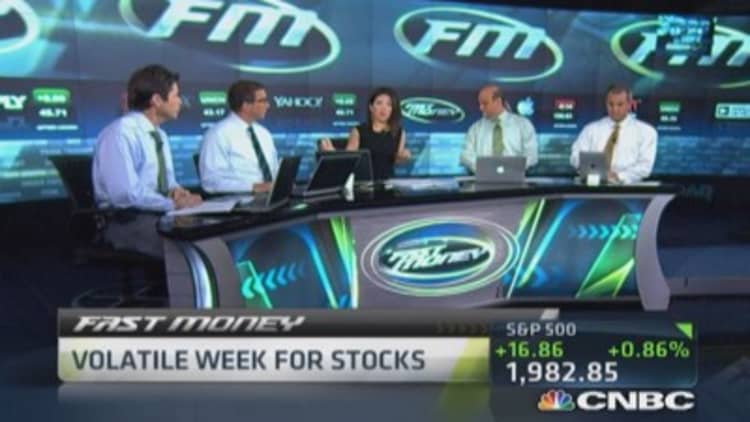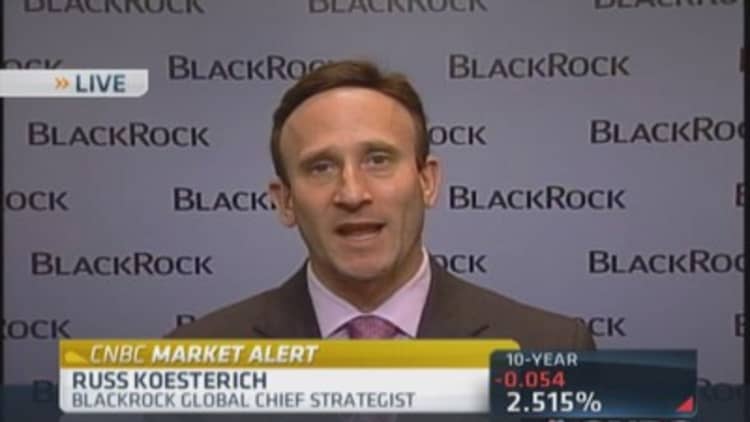
As the third quarter ends, the focus this coming week will be on the September jobs report, which could deliver proof that employment is improving enough to justify the Fed's move away from stimulus.
So, even with no Fed action or meeting on the near horizon, the week ahead is also about the Fed and its anticipated tightening regime versus other central banks. The European Central Bank meets Thursday and is expected to provide more details about its asset purchase program as the Fed moves away from bond buying—a phenomena that has helped give the dollar index a record 11 straight weeks of gains.
Economists expect to see about 215,000 nonfarm payrolls added in Friday's September jobs report, after August's disappointing 142,000—the first sub-200,000 report in seven months.
"The jobs report will let us know whether or not the Fed is going to have the ability in six months to do something, and the hope is you do get something like 215,000 but at least we do have a resilient economy even if we don't have a strong one. At least we'll have proof we're muddling in the right direction," said Zane Brown, fixed income strategist at Lord Abbett. "As for the ECB, we're hoping (ECB President Mario) Draghi comes up with something other than words."
Citigroup economists forecast payrolls at just 175,000, but they see continued solid improvement in hiring. "However, a calendar bias and payback from the surprisingly strong start of the year point to another soft employment reading for September. Since 2000, initial summer payroll estimates contained some of the weakest gains reported for the year," they noted.
Read MoreLots of 'ticking time bombs' out there: Sternlicht
With plenty of Fed speak but no one single event to frame it, the talk in markets this past week increasingly focused on the Fed's final launch of the last round of quantitative easing in October and the anticipated wind down in November of bond buying.
That event and the months of speculation ahead of a first rate cut sometime next year has already brought a new level of volatility to markets that strategists expect to see continue across different asset classes. The VIX, representing volatility in the , was up nearly 23 percent for the week.
The Dow, for instance, saw triple digit moves each day of the past week, for the first time in 16 months.
"We're getting closer to the first Fed tightening and what you should expect is happening and the volatility regime is starting to normalize. I think you'll have more volatility ahead and what you are starting to experience is what to expect going forward," said Russell Koestrich, BlackRock chief investment strategist.
Read MoreSo who's the next 'bond king'?
Brown agrees the markets are heading for a new period of volatility and he says ultimately, the Fed's rate hikes will be negative for the bond market.
"I think we'll have volatility because of the composition of the Fed, and because we're getting closer to how aggressive they're going to be and the reality of higher rates ... Even high yield is likely to give you less than coupon returns in the next year, and this will cause investors to examine their allocation between stocks and bonds. I think stocks end up doing okay," he said. While volatile, "bottom line stocks will outperform."
Stocks finished the week lower, even with two strong days of gains. The Dow ended the week, down nearly 1 percent at 17,113, while the S&P 500 ended the week at 1,982, a decline of 1.4 percent. The dollar index was trading at a four-year high with a gain of more than 1 percent in the past week. Treasury yields were higher Friday, with the U.S. 10-year at 2.53 percent in afternoon trading.
Read MoreBehind the high-yield bond crisis
Some parts of the markets were hit harder, including those most sensitive to Fed tightening or a higher dollar, and they led on the downside. That included small caps, evident in the Rydex Russell 2000; emerging markets—in the iShares MSCI Emerging Markets ETF, and junk bonds—SPDR Barclays High Yield Debt ETF.
"I think part of the market is in a mini correction mode. Emerging markets pulled back a fair amount since the summer," said Koesterich. He said the stocks may be more volatile but that does not necessarily mean bigger losses. "I don't think anything fundamentally changed. If you have a decent earnings period, which I expect, and the data comes in strong, but not too strong, I think the markets can recover."
Economists mostly expect the first rate hike to be in June, but some see it sooner, and at the heart of the debate is how rapidly the Fed will hike rates once it begins.

Brown said the market has yet to sort through the fact that the Fed, in its last forecast, upped expectations for rates at the end of next year higher than market expectations, while it also lowered its growth expectations to sub 3 percent in the next couple of years.
Volatility could result from the opposing views. "It's finally sinking in that at least the median projection of the Fed's expectations of fed funds is much more aggressive than that market anticipates. It suggests investors expect fed funds to be 72 basis points at the end of 2015. The Fed's median is 1.38," said Brown. "What's going to be the reality? Investors' expectations? or the Fed's expectations?"
Read MoreStocks closer to fully priced: Ex-Treasury chief
The dollar has responded to higher rate expectations, and Win Thin, senior currency strategist at Brown Brothers Harriman, sees the dollar continuing to strengthen. "I think you've got to go with this trend. Buy dollars. That seems to be doing magic right now," he said, noting the euro could be 1.24 against the dollar by year end. It fell below 1.27 in the past week.
"I think the market is overreacting to the Fed tightening story. Jobs are 200,000-220,000. There's not an imminent need to hike," Thin said.
The rising dollar is spilling into the equities market, particularly as it weighs on commodities prices, but also as a concern of how it might ultimately impact overseas sales of multinationals. Energy stocks, for instance, were down sharply, with Brent crude down nearly 6 percent month-to-date.
The sector was down nearly 2 percent in the past week, one of the worst performers, while the stocks are down nearly 6 percent for the month. Industrials, also dollar exposed, were the worst performers, as investors look for shelter in domestic oriented companies with less foreign exposure.
Read MoreFund flows flashing that there's danger ahead
For the quarter, the dollar index is up 7 percent. Gina Martin Adams, institutional equity strategist at Wells Fargo Securities, said there are only nine quarters in the past 25 years, where the dollar index has gained more than 5 percent. She does not expect a big impact on the overall earnings of the S&P 500 but says some sectors vulnerable to dollar exposure could show impact or make forward comments about currency impact.
"The only impact we've had to earnings in the last few weeks has been negative because oil prices have fallen," she said. "The weakness in oil is absolutely damaging energy sector estimates. Revisions momentum in the energy sector is down 25 percent over the last four weeks."
She and Koesterich said it is early to see widespread impact in actual earnings reports. "It's the preannouncement season we're getting into. We can't dismiss the earnings impact of all these moving parts. What the real earnings impact and how that's unfolding, it can make a very big difference for sectors," she said. "Earnings season depends on how much is priced in before it happens. Right now, it seems to me we're pricing in the worst earnings outlooks. Certainly, energy analysts are marking down their expectations. It remains to be seen if it spreads broadly to other sectors."
The other sectors most affected by dollar correlation are materials, staples, health care and industrials. She said the consumer sector has the most companies likely to trade with dollar strength and energy and materials are most likely to be hurt by a stronger dollar. Alcoa reports Oct. 8, and the earnings season gets underway the following week with big bank earnings.
What to watch
Monday
Earnings: Cal-Maine Foods, Cintas, Synnex
8:30 a.m.: Personal income
10:00 a.m.: Pending home sales
10:30 a.m.: Dallas Fed survey
Tuesday
Earnings: Walgreen
9:00 a.m.: S&P/Case-Shiller home prices
9:45 a.m.: Chicago PMI
10:00 a.m.: Consumer confidence
Wednesday
Earnings: Accuity Brands
Monthly vehicle sales
8:15 a.m.: ADP employment
10:00 a.m.: ISM manufacturing
10:00 a.m.: Construction spending
Thursday
Earnings: Constellation Brands, McCormick, Actuant, Global Payments
8:30 a.m.: Initial claims
10:00 a.m.: Factory orders
Friday
8:30 a.m.: Employment report
8:30 a.m.: International trade
10:00 a.m.: ISM nonmanufacturing


